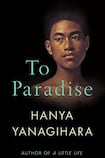
When word got out that Hanya Yanagihara had a new novel coming out, the running joke was to schedule therapy sessions around its release date. Her previous novel, the Booker-shortlisted bestseller A Little Life (2015) – a harrowing tale of abuse – is a perennial favourite on TikTok “books that made me cry” reels.
The good – or bad – news, depending on whether you’re after a tearjerker, is that To Paradise leaves readers’ eyes dry. The saga imagines an alternate America in three eras: at the ends of the 19th, 20th and 21st centuries. Its three parts are seemingly related through recurring character names (based on American missionaries to Hawaii, where Yanagihara spent part of her childhood) and places, including a townhouse on Washington Square. Unlike the reincarnation device in David Mitchell’s Cloud Atlas (2004), however, there are no further links between the characters.
“The people always had different selves, but the names themselves remain,” Yanagihara has explained. “Just like the name of America remains for each generation, but America itself is something quite different.”
Book I is set in 1893, with New York part of a group of “Free States” after the southern colonies have seceded. Although marriage equality makes the Free States seem more progressive than the rest of the country, blacks are still not accepted as full citizens.
Washington Square
Alluding to Henry James’s Washington Square, David Bingham, the eldest heir to a wealthy founding family, rejects an arranged marriage to a widower after falling for a musician whom his grandfather suspects is after his money. As David prepares to forgo his inheritance to follow his heart “to paradise”, Yanagihara truncates the story without resolution.
She teases us by having another character hear David’s story two centuries later, only to have the storyteller disappear before finishing. “I knew it was foolish, because they weren’t even real people,” says the frustrated listener, “but I thought about them often. I wanted to know what had become of them.”
Book II takes place in 1993, with the Aids crisis in full swing (a collective trauma conspicuously absent from A Little Life). It’s told from the point of view of another David Bingham, this time a Hawaiian paralegal living in Washington Square with his partner, Charles, a senior lawyer. Charles is HIV-positive but still healthy and helping friends who are dying of the disease. David’s estranged father, meanwhile, writes to him from a mental institution in Hawaii, explaining how he came to be disowned by the family. Bedridden, he imagines himself walking “to paradise” if his son answers his plea to visit.
The third of Yanagihara’s American experiments, comprising about half of the book’s 700-plus pages, is a totalitarian dystopia set in 2093. Heterosexual marriage has become compulsory due to successive pandemics depleting the population. With temperatures high enough to require cooling suits, food, water and books are rationed. Big Brother is watching in the form of a Fly that can read expressions, and the internet is illegal.
Cryptic love notes
We see this new world through the eyes of Charlie, a lab tech who lives with her husband in one of what have become eight apartments in the Washington Square house. She survived the “illness of ’70”, but the viral drug that saved her left her sterile and affectless. (Yanagihara is an admirer of Kazuo Ishiguro; Charlie’s voice bears a strong resemblance to that of the narrator of Never Let Me Go.) Although she agreed to a platonic marriage, Charlie is unnerved by cryptic love notes she finds among her husband’s things. She begins to follow him to clandestine visits to the same house each week, where a man opens the door. She, in turn, strikes up a friendship with a mysterious man named David.
Charlie’s narrative is interspersed with lengthy letters from her scientist grandfather, Charles, addressed to a friend in England. Through the letters, we learn of his involvement in setting up quarantine camps, eventually leading to his execution, and the backstory of Charlie’s parents. Charles’s last letter imagines himself turning into a bird and flying “to paradise”.
The themes of To Paradise – pandemics, colonialism, unequal rights, the quest for compassion and care – are urgent, and the idea of an alternate America is all too real in a post-Trump era with Roe v Wade in jeopardy. For fiction to work, however, it has to transcend the ideas it aspires to represent.
Unlike the precise rendering of the fictional Micronesian island in Yanagihara’s 2013 debut, The People in the Trees, the world-building in To Paradise feels laboured. The characters often act as mouthpieces for concepts, with exposition eliding emotion. Despite the plethora of pages accorded to their development, they remain, alas, as unachieved as the American dream.













